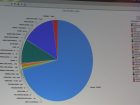
Features
Photo Gallery
Inside Panasonic’s Toughbook Mobility Forum 2017
Blue Line attended Panasonic Toughbook’s Mobility Forum 2017 last week for a look at new technology and inspirational words from former Canada Forces chief of defence staff Rick Hillier.
October 10, 2017 By Staff
 Rick Hillier with Panasonic Canada's Ashley Evans (right) and Susan Black.
Rick Hillier with Panasonic Canada's Ashley Evans (right) and Susan Black. “Inspire people by operating on a system of values and living them… Define your great mission so people can follow it,” Hillier told the room of about 80 people in downtown Toronto. “Bring your mind to work as well as your body.”
And don’t forget to “dampen” you egotism, he added.
“Leaders eat last.”
Later, Panasonic’s Matthew Eades, business development and public safety manager, delved into storage orchestration, kicking things off with a thought-provoking question:
He kicked things off with a thought-provoking question:
“Wouldn’t it be great for police departments to have one search function of their own for all their applications?”
He launched into a demonstration of the Panasonic Evidence Management Solution, featuring an “automatic metadata sync” to keep police agencies’ database storage clean and organized.
This solution makes it easier for officers to access their own videos, scanned notes, etc., Eades said. It is essentially an online-hosted review platform with “instant access” across the data investigation spectrum. It’s accessible on any device, including tablets, handhelds and two-in-ones.
“Everything is logged,” he explained. “You can view evidence from officer to district to department… The chief can log in by mobile device and see what’s happened that day and who did what…”
Evidence review and collaboration can be streamlined by sharing saved searches and searches are also multi-modal, including conceptual search, faceted search as well as traditional keyword search.
Classification tags — “DUI,” for example — help with retention policy rules, as they can be built in to stay stored for a specified amount of time, Eades continued.
The system is built to process upwards of a billion evidence files and can manage hundreds of simultaneous users, according to Panasonic. It adds: the overall point is to help investigators stay focused on the evidence, not the reporting.
“It can also help police organizations to develop best practices by identifying unclassified videos,” Eades said. In the example he showed the forum crowd, about 236,000 videos were not classified. “You could find these quickly and immediately amend classification policies, if required… These videos are just taking up storage and we don’t know what they even are.”
While storing data on the Cloud can be cheap, it’s a “black hole” type of option, according to Eades, as it can also become quickly expensive if you’re storing everything that way.
“With analytics, we show you where you can move your data around for cost savings.”
He went on to note police agencies could save on storage by using the H.265 video compression standard (also known as High Efficiency Video Coding or HEVC) when it comes to video capture, especially for body worn cameras, as there is less data to deal with. This is in comparison to H.264 (Advanced Video Coding).
“Nothing kills a project like storage,” Eades concluded.
Magnus McDermid, vice-president of Enterprise Solutions Panasonic Canada and Mobility Panasonic Solutions North America, also highlighted the Toughbook’s 21-year history and the company’s recent acquisition of Zetes Industries, a European company specializing in automatic identification technology.
For more, see Blue Line’s story from the Panasonic Toughbook 33’s big reveal in New York City earlier this year on page 7 in our June/July issue.
Photos: R. Francoeur
Print this page








